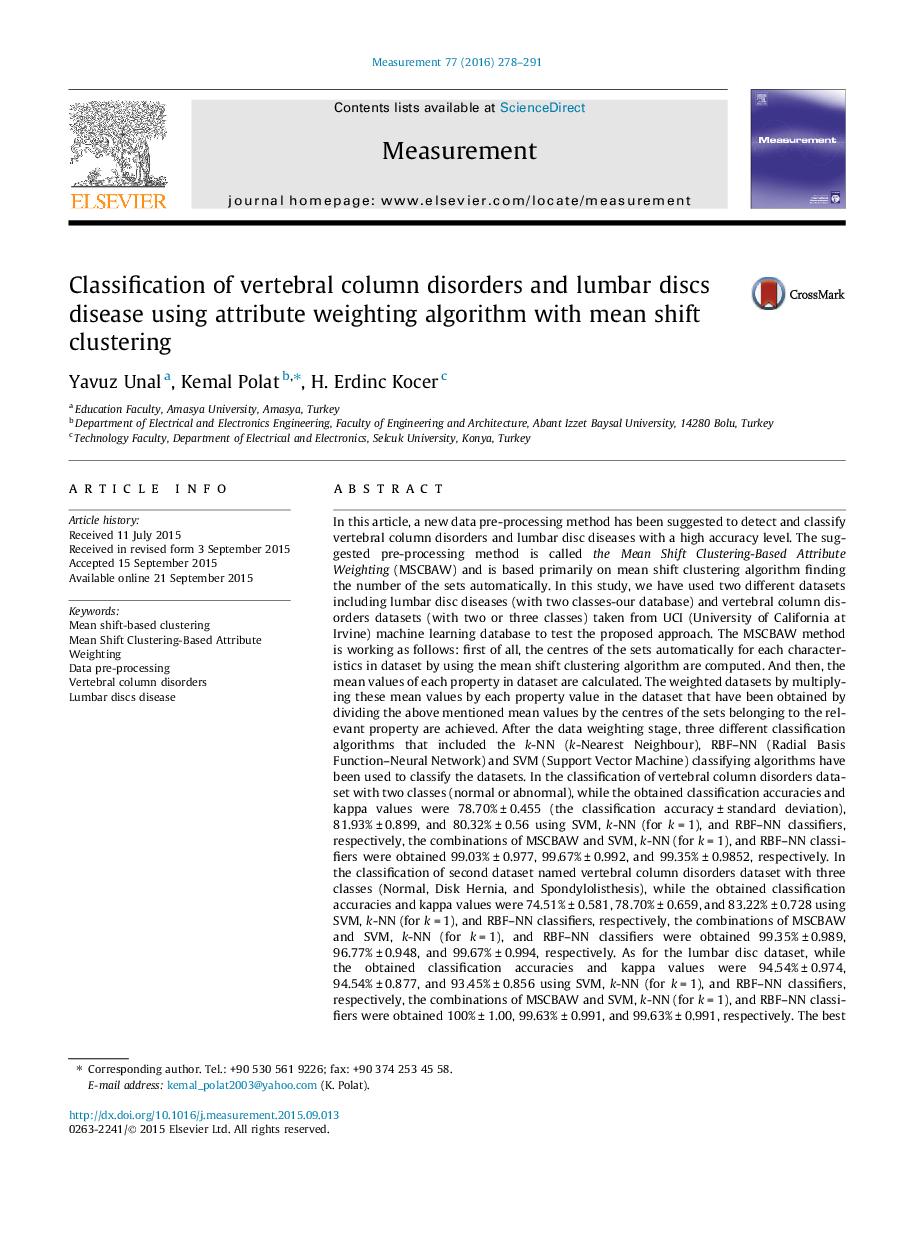| کد مقاله | کد نشریه | سال انتشار | مقاله انگلیسی | نسخه تمام متن |
|---|---|---|---|---|
| 729998 | 1461510 | 2016 | 14 صفحه PDF | دانلود رایگان |
In this article, a new data pre-processing method has been suggested to detect and classify vertebral column disorders and lumbar disc diseases with a high accuracy level. The suggested pre-processing method is called the Mean Shift Clustering-Based Attribute Weighting (MSCBAW) and is based primarily on mean shift clustering algorithm finding the number of the sets automatically. In this study, we have used two different datasets including lumbar disc diseases (with two classes-our database) and vertebral column disorders datasets (with two or three classes) taken from UCI (University of California at Irvine) machine learning database to test the proposed approach. The MSCBAW method is working as follows: first of all, the centres of the sets automatically for each characteristics in dataset by using the mean shift clustering algorithm are computed. And then, the mean values of each property in dataset are calculated. The weighted datasets by multiplying these mean values by each property value in the dataset that have been obtained by dividing the above mentioned mean values by the centres of the sets belonging to the relevant property are achieved. After the data weighting stage, three different classification algorithms that included the k-NN (k-Nearest Neighbour), RBF–NN (Radial Basis Function–Neural Network) and SVM (Support Vector Machine) classifying algorithms have been used to classify the datasets. In the classification of vertebral column disorders dataset with two classes (normal or abnormal), while the obtained classification accuracies and kappa values were 78.70% ± 0.455 (the classification accuracy ± standard deviation), 81.93% ± 0.899, and 80.32% ± 0.56 using SVM, k-NN (for k = 1), and RBF–NN classifiers, respectively, the combinations of MSCBAW and SVM, k-NN (for k = 1), and RBF–NN classifiers were obtained 99.03% ± 0.977, 99.67% ± 0.992, and 99.35% ± 0.9852, respectively. In the classification of second dataset named vertebral column disorders dataset with three classes (Normal, Disk Hernia, and Spondylolisthesis), while the obtained classification accuracies and kappa values were 74.51% ± 0.581, 78.70% ± 0.659, and 83.22% ± 0.728 using SVM, k-NN (for k = 1), and RBF–NN classifiers, respectively, the combinations of MSCBAW and SVM, k-NN (for k = 1), and RBF–NN classifiers were obtained 99.35% ± 0.989, 96.77% ± 0.948, and 99.67% ± 0.994, respectively. As for the lumbar disc dataset, while the obtained classification accuracies and kappa values were 94.54% ± 0.974, 94.54% ± 0.877, and 93.45% ± 0.856 using SVM, k-NN (for k = 1), and RBF–NN classifiers, respectively, the combinations of MSCBAW and SVM, k-NN (for k = 1), and RBF–NN classifiers were obtained 100% ± 1.00, 99.63% ± 0.991, and 99.63% ± 0.991, respectively. The best hybrid models in the classification of vertebral column disorders dataset with two classes, vertebral column disorders dataset with three classes, and lumbar disc dataset were the combination of MSCBAW and k-NN classifier, the combination of MSCBAW and RBF–NN classifier, and the combination of MSCBAW and SVM classifier, respectively.
Figure optionsDownload as PowerPoint slide
Journal: Measurement - Volume 77, January 2016, Pages 278–291
